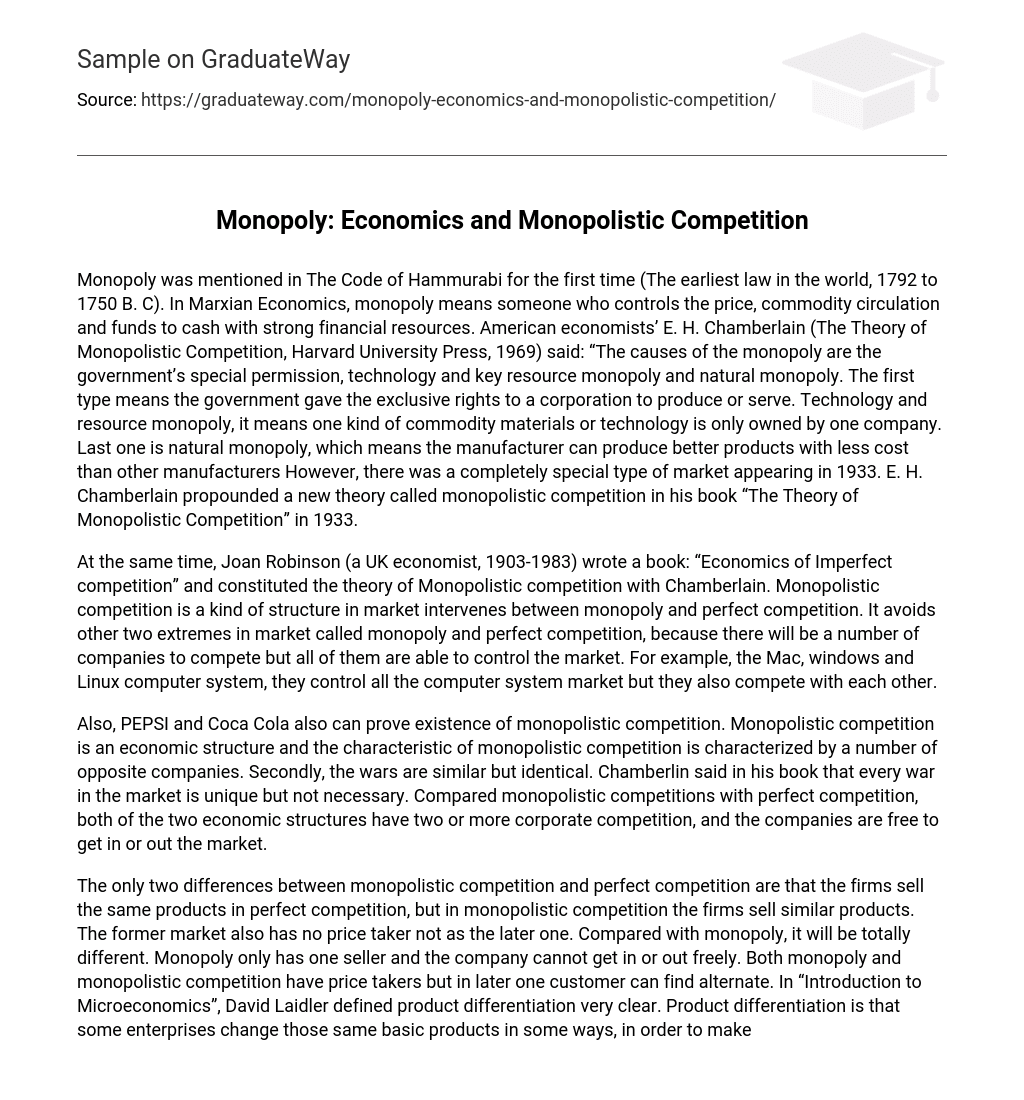Monopoly was mentioned in The Code of Hammurabi for the first time (The earliest law in the world, 1792 to 1750 B. C). In Marxian Economics, monopoly means someone who controls the price, commodity circulation and funds to cash with strong financial resources. American economists’ E. H. Chamberlain (The Theory of Monopolistic Competition, Harvard University Press, 1969) said: “The causes of the monopoly are the government’s special permission, technology and key resource monopoly and natural monopoly. The first type means the government gave the exclusive rights to a corporation to produce or serve. Technology and resource monopoly, it means one kind of commodity materials or technology is only owned by one company. Last one is natural monopoly, which means the manufacturer can produce better products with less cost than other manufacturers However, there was a completely special type of market appearing in 1933. E. H. Chamberlain propounded a new theory called monopolistic competition in his book “The Theory of Monopolistic Competition” in 1933.
At the same time, Joan Robinson (a UK economist, 1903-1983) wrote a book: “Economics of Imperfect competition” and constituted the theory of Monopolistic competition with Chamberlain. Monopolistic competition is a kind of structure in market intervenes between monopoly and perfect competition. It avoids other two extremes in market called monopoly and perfect competition, because there will be a number of companies to compete but all of them are able to control the market. For example, the Mac, windows and Linux computer system, they control all the computer system market but they also compete with each other.
Also, PEPSI and Coca Cola also can prove existence of monopolistic competition. Monopolistic competition is an economic structure and the characteristic of monopolistic competition is characterized by a number of opposite companies. Secondly, the wars are similar but identical. Chamberlin said in his book that every war in the market is unique but not necessary. Compared monopolistic competitions with perfect competition, both of the two economic structures have two or more corporate competition, and the companies are free to get in or out the market.
The only two differences between monopolistic competition and perfect competition are that the firms sell the same products in perfect competition, but in monopolistic competition the firms sell similar products. The former market also has no price taker not as the later one. Compared with monopoly, it will be totally different. Monopoly only has one seller and the company cannot get in or out freely. Both monopoly and monopolistic competition have price takers but in later one customer can find alternate. In “Introduction to Microeconomics”, David Laidler defined product differentiation very clear. Product differentiation is that some enterprises change those same basic products in some ways, in order to make consumers believe that these products have distinct differences and it will produce different preferences”. He believes that the reason why product differentiation is that the sellers have different sell behaviours, such as advertising sales promotion. It makes people believe their productions are special. Product differentiation also is very important factor in market and the enterprises control market depending on how they make their own product differentiation degree successfully.
N. Gregory Mankiw (a Ukrainian-American macroeconomist) wrote a book named “principles of economics” (print by higher education, 2005-4). In this book he compared monopolistic competition in short-run and long-run economic. Prices are decided by the demand curve and the price is always higher than marginal cost. The condition of balance in monopolistic competition short-run production is MR=SMC (MR=marginal revenue, SMC=short-run marginal cost). In long-run monopolistic competition if the company wants balance, MR=LMC=SMC and AR=LAC=SAC (AC=average cost).
He also said: ‘there is no excess capacity in long run higher education. ” Free entry results in competitive firms producing at the point where average total cost is minimized, which is the efficient scale of the firm. But in monopolistic competition is totally different. ’ Monopolistic competition is not as effective as perfect competition and price always higher than marginal cost. New production might cause consumer surplus and let market suffer loss. Monopoly will exist in anywhere and affect market all the time. However, there are not only monopoly and competition in this world; they can also be ombined into a new competition to affect the market. In Modern society market monopolistic competition, there are a lot of examples like soft drink, computers, laptops and cars. Monopolistic competition also is very important today. After monopolistic competition was advanced, the economists started to deliberate it. In addition, monopolistic competition became a common phenomenon in modern society. Countries enacted law to control monopoly and the principles they made are similar to this theory. For example, the antitrust law in the United States, China and European countries were affected by that.





